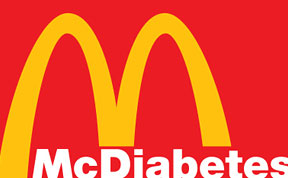
"If man made it, don't eat it."
Corporations
are putting consumers at risk!
They
exist to make money for stockholders,
not to serve the needs of the consumer.
They're about sales, not about service.
It's a matter of profit over prudence.
Too big to fail is too big to serve.
To serve is to succeed.
See 'Doctors' video.
CONSUMER ALERT
What's
Lurking In Your Food?
6 Food Additives To Subtract From Your Diet
By Wyatt Myers for EverydayHealth.com
Could
flavorings, sweeteners, and other food additives be adding
to or even causing you chronic pain? Here's what you need to know.
When you injure yourself, it's easy to understand the source of your
pain. But for some pain conditions, such as fibromyalgia, migraine,
and arthritis, deciphering the source is not as simple. Now, a growing
volume of research is indicating that what you eat, including some
common additives found in many packaged and processed foods, might
play a role in chronic pain.
But if you're like many Americans, these foods make up a substantial
portion of your diet. According to a report in the New York Times,
Americans buy 787 pounds of processed food like microwave dinners
and salty snacks per year, compared with only 602 pounds of fresh
food. Staying away from these items can boost your overall health
as well as helping to manage pain.
Additives to Avoid
Here are six food
additives it makes sense to avoid as part of your pain
management plan.
![]() Artificial
Sweeteners: Artificial
sweeteners like Aspartame (NutraSweet)
and Splenda, which are found in diet drinks
and foods as well as those little packets on restaurant tables, were
developed as safe, healthy substitutes for sugar. But research has
linked these food additives to a variety of chronic pain conditions,
including fibromyalgia and migraines. "One patient I worked with
who came in for chronic headaches drank two diet sodas every day,"
says Peter Bongiorno, ND, a naturopathic physician with InnerSource
Health in New York City. "He had been to five doctors and was
on three pain medications. Once we removed the diet soda from his
diet and had him replace it with water, his headaches stopped."
Artificial
Sweeteners: Artificial
sweeteners like Aspartame (NutraSweet)
and Splenda, which are found in diet drinks
and foods as well as those little packets on restaurant tables, were
developed as safe, healthy substitutes for sugar. But research has
linked these food additives to a variety of chronic pain conditions,
including fibromyalgia and migraines. "One patient I worked with
who came in for chronic headaches drank two diet sodas every day,"
says Peter Bongiorno, ND, a naturopathic physician with InnerSource
Health in New York City. "He had been to five doctors and was
on three pain medications. Once we removed the diet soda from his
diet and had him replace it with water, his headaches stopped."
![]() Sugar:
Sugar
may seem like a more "natural" sweetener than sugar substitutes,
but it still causes pain management problems for many people. "Sugar
is a common pain trigger," says Jacob Teitelbaum, MD, director
of the Fibromyalgia and Fatigue Centers and author of Pain Free 1-2-3:
A Proven Program for Eliminating Chronic Pain Now. "It can trigger
swings that can throw muscles into spasm." See Sugar
Is a Four Letter Word. See Sugar: The
Bitter Truth. See Toxic
Food Additives To Avoid.
Sugar:
Sugar
may seem like a more "natural" sweetener than sugar substitutes,
but it still causes pain management problems for many people. "Sugar
is a common pain trigger," says Jacob Teitelbaum, MD, director
of the Fibromyalgia and Fatigue Centers and author of Pain Free 1-2-3:
A Proven Program for Eliminating Chronic Pain Now. "It can trigger
swings that can throw muscles into spasm." See Sugar
Is a Four Letter Word. See Sugar: The
Bitter Truth. See Toxic
Food Additives To Avoid.
![]() High-Fructose
Corn Syrup: Also known as HFCS
and Corn
Sugar, this sweetener used in many packaged products like soda,
cakes, and candy has received a lot of bad press lately. Though some
believe that HFCS is likely no worse for your health than standard
sugar, that doesn't necessarily make it a good thing. Some studies
have shown that some people have an intolerance to High-Fructose Corn
Syrup that can lead to chronic abdominal pain and other digestive
disorders. See Sugar
Is a Four Letter Word.
High-Fructose
Corn Syrup: Also known as HFCS
and Corn
Sugar, this sweetener used in many packaged products like soda,
cakes, and candy has received a lot of bad press lately. Though some
believe that HFCS is likely no worse for your health than standard
sugar, that doesn't necessarily make it a good thing. Some studies
have shown that some people have an intolerance to High-Fructose Corn
Syrup that can lead to chronic abdominal pain and other digestive
disorders. See Sugar
Is a Four Letter Word.
![]() Salt:
Most experts agree that salt
is not directly linked to pain. However, we have become so addicted
to salt that the overabundance of the mineral is now indirectly leading
to pain in many people, says Dr. Bongiorno. "In some individuals,
salt intake can allow the body to retain water in its tissues. The
pressure of this water can squeeze and impinge on nerve and joint
function, which can increase pain," he explains. "It may
be worth trying a salt-free diet to see if it decreases pain."
Bongiorno adds, "Everyone should avoid foods with added salt."
See The Case For and Against Salt.
Salt:
Most experts agree that salt
is not directly linked to pain. However, we have become so addicted
to salt that the overabundance of the mineral is now indirectly leading
to pain in many people, says Dr. Bongiorno. "In some individuals,
salt intake can allow the body to retain water in its tissues. The
pressure of this water can squeeze and impinge on nerve and joint
function, which can increase pain," he explains. "It may
be worth trying a salt-free diet to see if it decreases pain."
Bongiorno adds, "Everyone should avoid foods with added salt."
See The Case For and Against Salt.
![]() MSG:
Most people think of the food additive monosodium glutamate, or MSG,
as a flavor enhancer used in Chinese food, but it is also incorporated
into many processed foods. In studies, it seems to have the same impact
on chronic pain conditions as artificial sweeteners. "Glutamate
(a component of MSG), can damage nerve endings when taken in excess.
When this happens there is an amplification of pain," says Barbara
Mendez, MS, RPh, a pharmacist and nutritional consultant in New York.
"I would recommend that people read labels carefully and avoid
anything with MSG." Other names for MSG include glutamic acid,
yeast extract, hydrolyzed protein, sodium caseinate, and autolyzed
yeast.
MSG:
Most people think of the food additive monosodium glutamate, or MSG,
as a flavor enhancer used in Chinese food, but it is also incorporated
into many processed foods. In studies, it seems to have the same impact
on chronic pain conditions as artificial sweeteners. "Glutamate
(a component of MSG), can damage nerve endings when taken in excess.
When this happens there is an amplification of pain," says Barbara
Mendez, MS, RPh, a pharmacist and nutritional consultant in New York.
"I would recommend that people read labels carefully and avoid
anything with MSG." Other names for MSG include glutamic acid,
yeast extract, hydrolyzed protein, sodium caseinate, and autolyzed
yeast.
![]() Preservatives:
One of the reasons that many foods can last so long on store shelves
is due to the addition of preservatives, chemicals (with names like
benzoates, monoglycerides, diglycerides,
nitrates, nitrites, and sulfites) that keep the food from spoiling.
A number of studies have also linked some of these preservatives to
chronic pain conditions. Says Mendez, "These preservatives are
often found in commercially prepared baked goods, so consider making
your own homemade products." One added benefit: When you bake
your own goodies, you can control how much sugar goes in.
Preservatives:
One of the reasons that many foods can last so long on store shelves
is due to the addition of preservatives, chemicals (with names like
benzoates, monoglycerides, diglycerides,
nitrates, nitrites, and sulfites) that keep the food from spoiling.
A number of studies have also linked some of these preservatives to
chronic pain conditions. Says Mendez, "These preservatives are
often found in commercially prepared baked goods, so consider making
your own homemade products." One added benefit: When you bake
your own goodies, you can control how much sugar goes in.
Here's the take-away: Whenever possible, choose fresh foods over prepared
items to help decrease your pain and improve your health. See
Toxic
Food Additives To Avoid.
The
links below contain data regarding the ongoing consumer health risks
posed by the current activities and marketing strategies of many food
and drug corporations, which endanger the quality of life of many
unsuspecting consumers. Check out the marked (![]() ) links
especially.
) links
especially.
The corporate-military-industrial complex, as described by American presidents Dwight D. Eisenhower and John F. Kennedy, is alive and flourishing. Only consumers, acting as an informed electorate, can put an end to these activities. Please check out the links below, then take action here!
![]() Factoid
Factoid
Due
to the power and corrupting influence of Big
Pharma, the teaching
of nutritional science and the use of vitamin and herbal supplements
is
not taught to any significant extent in our medical schools. The obvious
reason is that teaching this science reduces the use of prescription
drugs.
![]()
Lasik Eye Surgery - FDA Warning
http://en.wikipedia.org/wiki/Preservative
![]()
http://www.naturalnews.com/007024.html
http://www.rense.com/general52/msg.htm
http://en.wikipedia.org/wiki/Titanium_dioxide
http://en.wikipedia.org/wiki/Azodicarbonamide
http://en.wikipedia.org/wiki/Polydimethylsiloxane
http://www.foodadditivesworld.com/preservatives.html
![]()
http://www.preventcancer.com/consumers/food/hotdogs.htm
![]()
http://www.diet-blog.com/07/whats_lurking_in_fast_food.php
![]()
http://ezinearticles.com/?The-Dangers-of-Fast-Food&id=1592564
http://www.ab-core-and-stomach-exercises.com/supersize-me.html
http://eastviewchemistry.pbworks.com/w/page/31614716/Fast-Food-and-Preservatives
![]()
![]()
Pages And Points To Ponder
![]() *Consultation
with a health care professional should occur before applying
adjustments or treatments to the body, consuming medications
or nutritional supplements and before dieting, fasting or exercising.
None of these activities are herein presented as substitutes
for competent medical treatment. See
Disclaimer.
*Consultation
with a health care professional should occur before applying
adjustments or treatments to the body, consuming medications
or nutritional supplements and before dieting, fasting or exercising.
None of these activities are herein presented as substitutes
for competent medical treatment. See
Disclaimer.
Khalsa
WebMasters.com
© All rights reserved.
Presented
as a public service.




